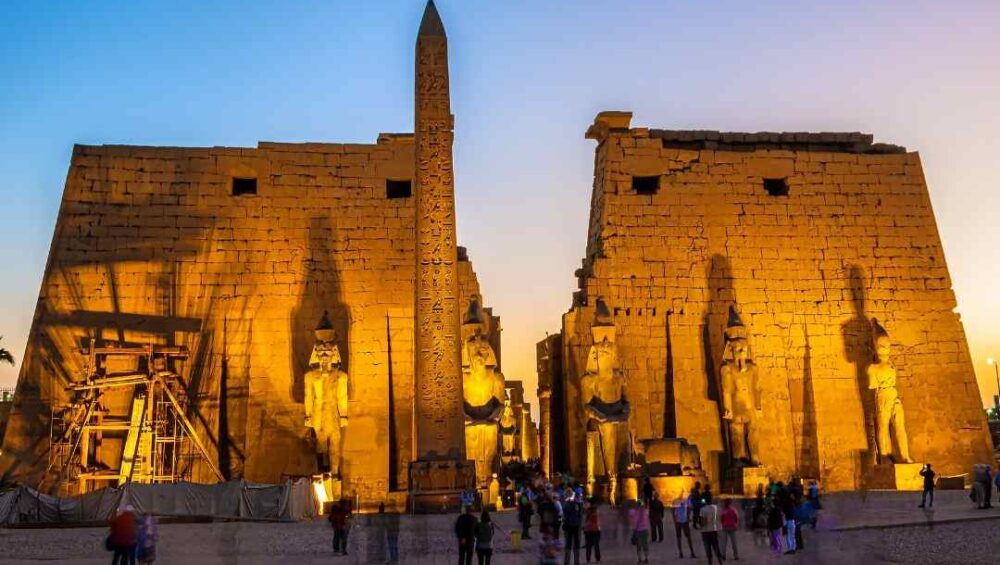Luxor Temple is more than just an archaeological site; it’s a mesmerizing portal into Ancient Egypt’s spiritual and cultural past. Situated on the east bank of the Nile River in Luxor, this grand temple complex showcases stunning architecture, intricate carvings, and a rich history that spans millennia. Visiting Luxor Temple is like stepping into a living museum where each corner tells a story of gods, kings, and the vibrant civilization of ancient Thebes.
In this comprehensive guide, we’ll delve into the wonders of the Temple, including its history, key features, and practical travel tips. Whether you’re a history enthusiast, a casual traveler, or someone planning an epic Egyptian adventure, this guide will help you explore Luxor Temple with ease.
Discover Egypt’s wonders from the water on our luxury Nile River cruise.
What Makes Luxor Temple Unique?
Luxor Temple stands apart from other Egyptian temples due to its significance in both ancient and modern history. Unlike other temples primarily dedicated to gods, Luxor Temple was a ceremonial site for the renewal of kingship. This focus on divine and earthly authority gives it a unique aura.
Why You Should Visit:
- Architectural Grandeur: Marvel at towering statues, colossal columns, and exquisite hieroglyphs.
- Historical Richness: Discover the temple’s role in the Opet Festival and its connection to other major temples like Karnak.
- Cultural Continuity: Witness how the Temple has been used through centuries, from ancient ceremonies to modern-day worship.
A Brief History
The Temple, originally known as Ipet Resyt (“Southern Sanctuary”), was built around 1400 BCE during the reign of Amenhotep III. Over time, other pharaohs, including Tutankhamun and Ramses II, added their touches to the temple, creating the masterpiece we see today.
Key Historical Periods:
- New Kingdom (1550-1070 BCE): The initial construction and major expansions took place during this era.
- Roman Period: Luxor Temple became part of a Roman military camp.
- Islamic Period: The mosque of Abu al-Haggag, built atop the temple, symbolizes its enduring cultural relevance.
Architectural Highlights of Luxor Temple
1. First Pylon
The towering gateway built by Ramses II is adorned with detailed carvings depicting his military victories. Two seated colossi of the pharaoh guard the entrance, along with an obelisk (its twin stands in Paris).
2. Courtyard of Ramses II
This spacious courtyard features columns shaped like papyrus plants and a series of statues depicting Ramses II.
3. Colonnade of Amenhotep III
One of the most striking features of the Temple, this corridor of 14 massive columns creates an awe-inspiring pathway leading deeper into the temple.
4. Inner Sanctuaries
The temple’s innermost areas include chapels dedicated to Amun, Mut, and Khonsu, the triad of Theban gods. The intricate carvings here narrate religious rituals and royal ceremonies.
5. Mosque of Abu al-Haggag
This active mosque sits atop the temple, blending Islamic heritage with ancient Egyptian history, making Luxor Temple a symbol of cultural continuity.
Fun Facts About Luxor Temple
- Home to the Opet Festival: Luxor Temple was central to this grand annual festival celebrating the rejuvenation of pharaonic power.
- Connected to Karnak Temple: An avenue of sphinxes, over 2 kilometers long, links Luxor Temple to Karnak, creating a stunning ceremonial route.
- Used by Alexander the Great: The Macedonian conqueror added his name to the temple’s inscriptions, claiming divine legitimacy.
Tips for Visiting The Temple
Best Time to Visit
- Ideal Months: October to April for cooler weather.
- Best Hours: Early morning or evening to avoid crowds and enjoy the temple’s illuminated beauty at night.
How to Get There
- The Temple is located in the heart of Luxor city and is easily accessible by taxi, tuk-tuk, or on foot if you’re staying nearby.
What to Bring
- Comfortable walking shoes.
- A hat and sunscreen.
- A camera to capture the stunning details.
Enhancing Your Experience
Guided Tours
Opt for a knowledgeable guide or an audio tour to gain deeper insights into the temple’s history and symbolism.
Combine with Other Attractions
Pair your visit those nearby landmarks like Karnak Temple, the Valley of the Kings, and the Luxor Museum.
Final Thoughts
Luxor Temple isn’t just a historical site; it’s a living testament to the enduring legacy of Ancient Egypt. From its grandiose architecture to its spiritual significance, every aspect of the temple offers a glimpse into a civilization that continues to fascinate the world.
Whether you’re tracing the footsteps of pharaohs, marveling at artistic masterpieces, or simply soaking in the atmosphere, the Temple promises an unforgettable experience. Start planning your trip to Egypt today and uncover the timeless beauty of this ancient marvel.
Ready to explore the wonders of Luxor Temple and beyond? Check out our exclusive Egypt travel packages to make your Egyptian adventure truly extraordinary!




